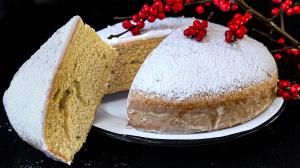The memories of my family’s new year’s VASILOPITA cake (celebrating Saint Basil) were it’s density and compactness, with the occasional large air bubbles appearing throughout its crumb, it’s tenderness and its moistness and the magical intermingling aromas of mastic resin, mahlab kernels, orange zests, nutmeg and cognac, and of course, the hope, that the winner of the hidden prize inside would get their new year’s wishes granted !
A “vasilopita” is a Greek as well as an Eastern European and Balkan traditional winter holiday cake, whether it’s a denser cake or a lighter & higher sweetened bread or even a flatter pie. It is what establishes the rhythm of the New Year, eaten at midnight for the bravest, or the morning after New Year’s Eve, for the more reasonable.
It always contains one coin or a trinket to be discovered, thus granting good luck to the winner for the rest of the year. A cross is etched on the surface and then the slices are cut and attributed to each person present as well as one slice for a symbolic guest or presence.
It’s an easy cake to make but I find that the best method to use is the reverse-creaming method. What does this imply ? Doing things backwards, in fact. Instead of beating the butter with the sugar, then adding the eggs and alternating the additions of the dry ingredients with the rest of the liquid ingredients, the reverse-creaming method regroups all the dry ingredients together, including the sugar, and then combines them with the butter, and then the other liquid ingredients, such as the eggs, buttermilk, orange juice, cognac and vanilla are added at the end. This method provides a denser cake with a tighter crumb and a flatter result, with less doming.
Of course, this approach is much easier in a large food processor, allowing you to coat the dry ingredients with the fat of the butter, somewhat like making pie dough or an easier version of puff-pastry. Both methods work and I show you both options but I have a preference for the food processor method for its ease as well as more satisfying end result.
The combined flavors of the mastic resin, mahlab kernels (reminiscent of cherry and almond), the orange zest, the nutmeg as well as orange and cognac, are reminiscent of Easter bread, but still different.
The final touch is often a sprinkling of icing sugar but I prefer a thicker coating of icing sugar and milk glazing and when that’s dry, a finishing sprinkling of dry icing sugar, like a coat of freshly fallen snow.
HAPPY NEW YEAR my dears and best wishes to all … :)















